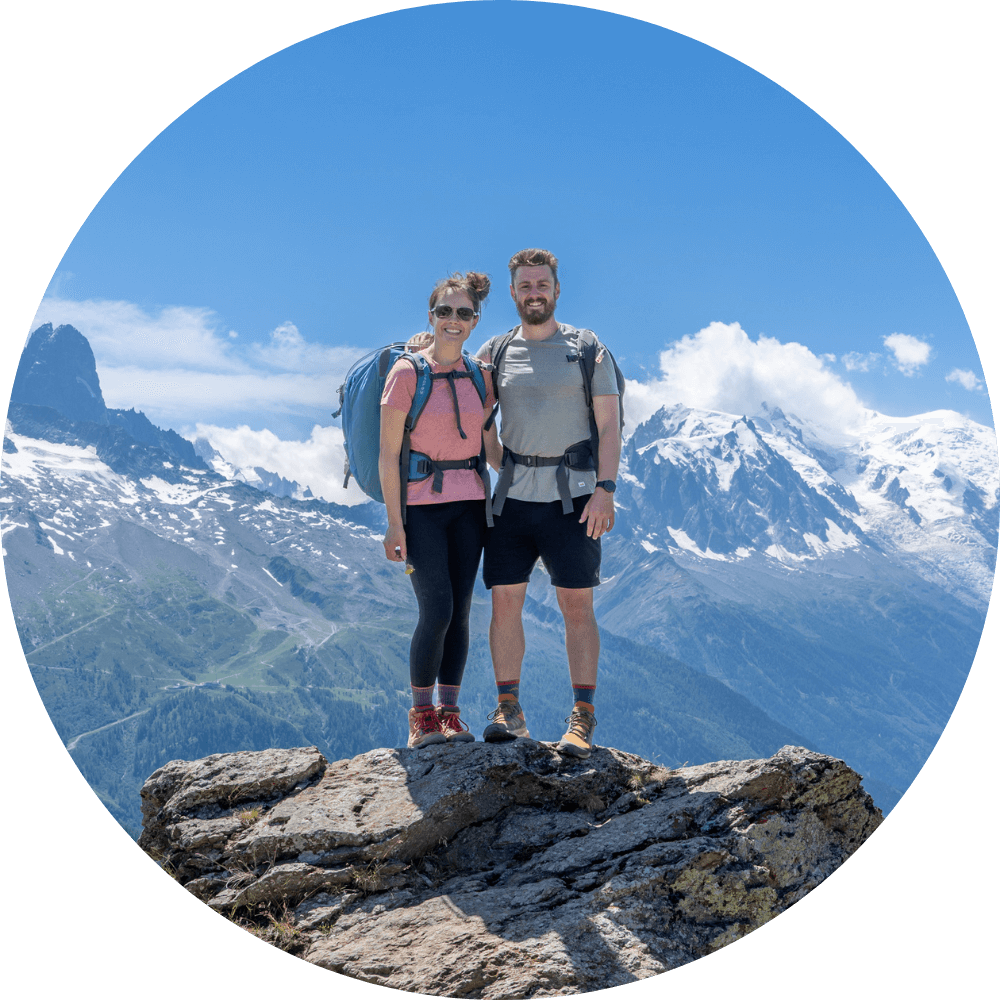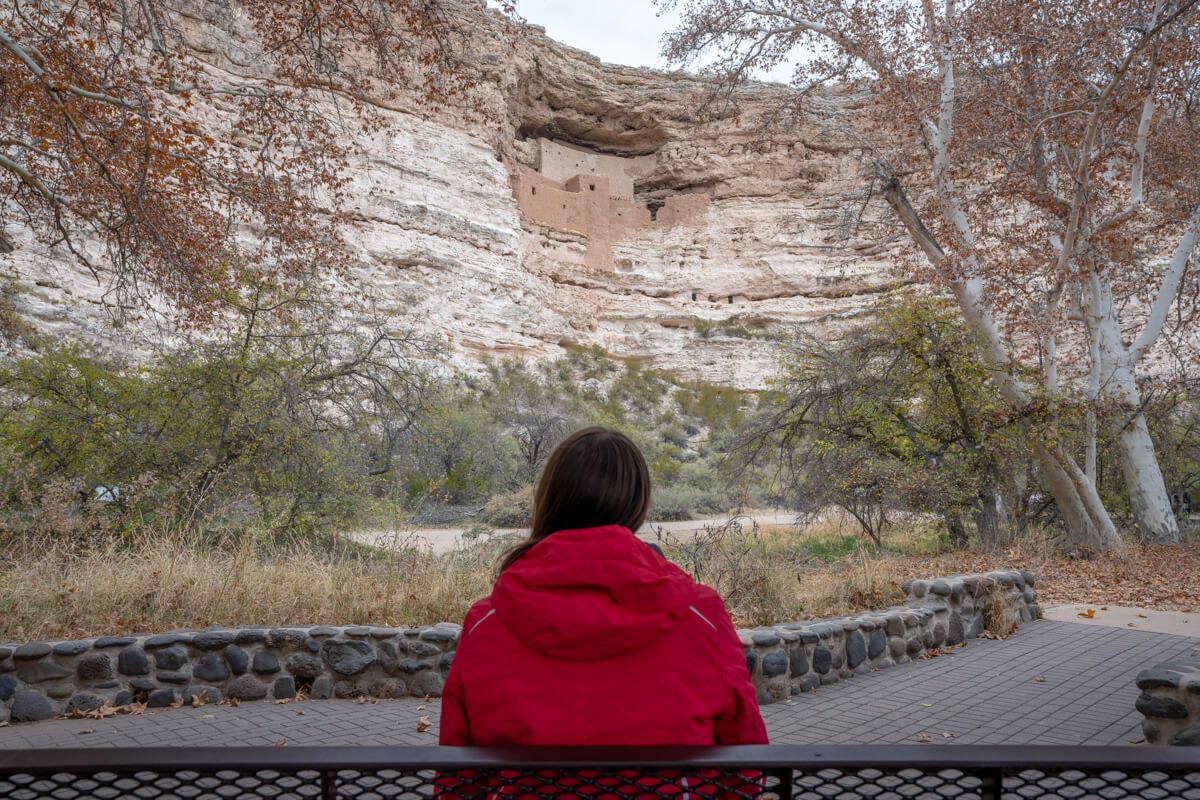Montezuma Castle is a US National Monument located in Yavapai Country near Sedona, Arizona. It’s one of the best-preserved cliff dwellings ever found in the American Southwest that was built by the Sinagua people from mud and stone. The monument is a great spot for families with kids and it’s open everyday from 8:00am-4:45pm.
In this guide we explain everything you need to know about visiting Montezuma Castle National Monument, based on our experiences. Read more about us.
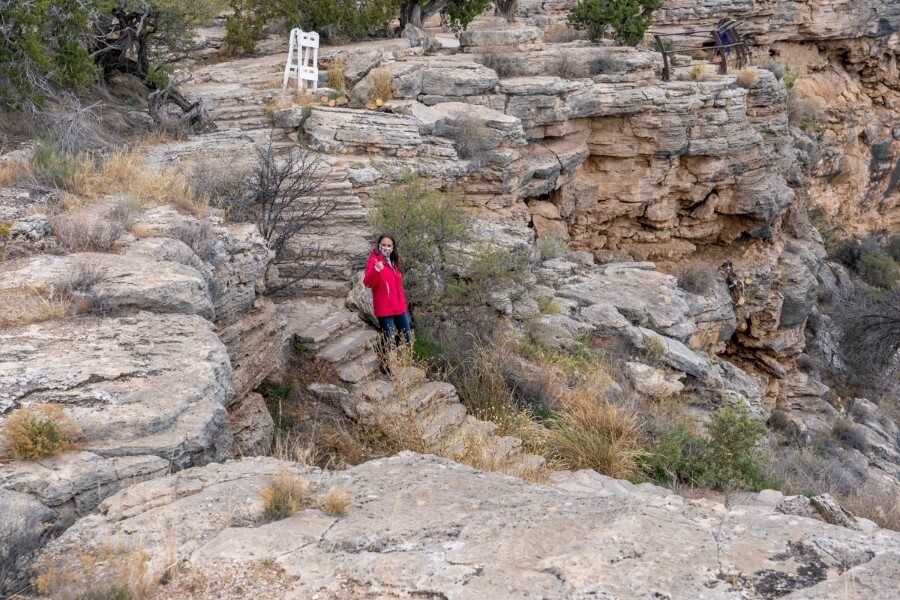
We visited Montezuma Castle National Monument on a chilly morning in December 2021 as part of an eight day vacation in Sedona. We’d already stopped off at Montezuma Well (which is a separate site belonging to the same monument and ticket price) before arriving at the Castle.
After paying for entry, we took a quick walk through the grounds and saw the main attraction: an old dwelling built high up into a tall cliff. It didn’t blow us away, but it was a nice escape from the crowded hiking trails in Sedona. You’ll see our photos and tips throughout this guide to help you plan a visit. Okay, let’s begin!
Note: Our content is reader supported and contains affiliate links. If you make a purchase through one of these links, we may earn a small commission at no extra cost to you and it helps us keep this site running.
SEDONA Planning
📖 Ultimate Sedona Guidebook: Get our complete 50+ page offline PDF with everything you need for Sedona.
📞 Personalized Sedona Planning Call: Book a 60 minute call with Mark to have your questions answered, optimize your itinerary, avoid tourist traps and get our best insider tips.
💡 Still Planning? Read our essential first-timer’s guide to visiting Sedona.
What Is Montezuma Castle?
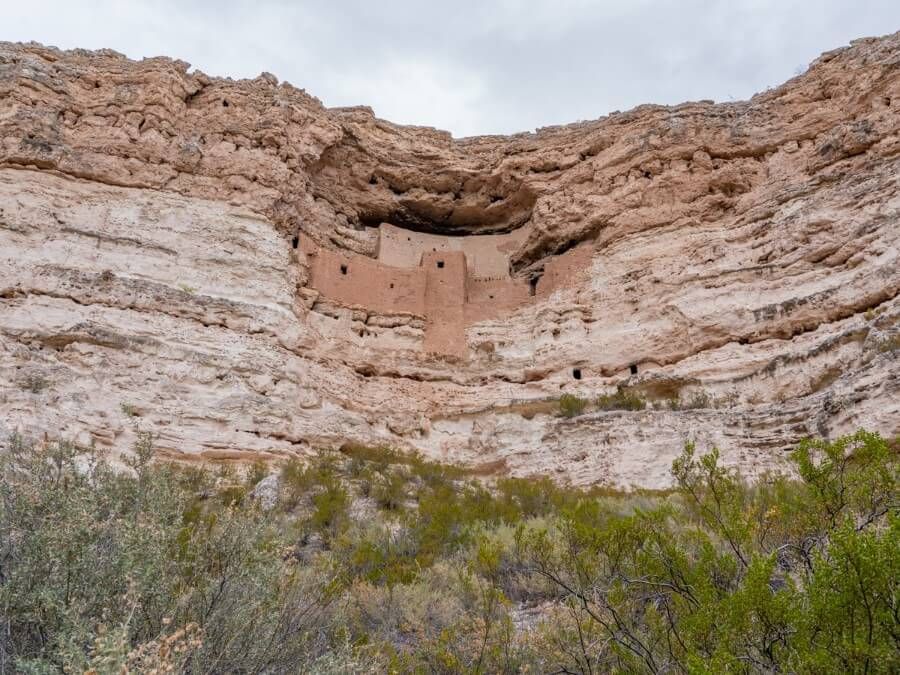
Montezuma Castle is one of the best-preserved ancient dwellings in central Arizona, and it’s one of several ancient ruins close to Sedona. Its star attraction is a five-story dwelling carved into a white limestone cliff with 20 rooms covering 3,500 square feet of floor space. Pretty impressive, right?
The dwelling sits 100 feet above Beaver Creek in the Verde Valley. It provides incredible insight into the history of the ancient farmers from the surrounding region. Archaeological research has shown Montezuma Castle was built by the Sinagua people between 1100 and 1300 AD.
The dwelling was inhabited for about 300 years until their abandonment around 1450 AD. It’s still a mystery as to why the Sinagua people migrated northward to other pueblo villages including overpopulation, depletion of resources, conflict, disease, spiritual beliefs and climate change.
This time period marked a collapse of the major civilizations in the Southwest. When early American settlers first found the dwelling in the 1860s, they mistakenly assumed the structure was Aztec in origin, naming it Montezuma Castle.
Archeological studies proved this nomenclature to be incorrect because the dwelling was built by the Sinagua people. However, the name has remained even though there is no connection to the famous Aztec emperor Montezuma.
National Monument Status
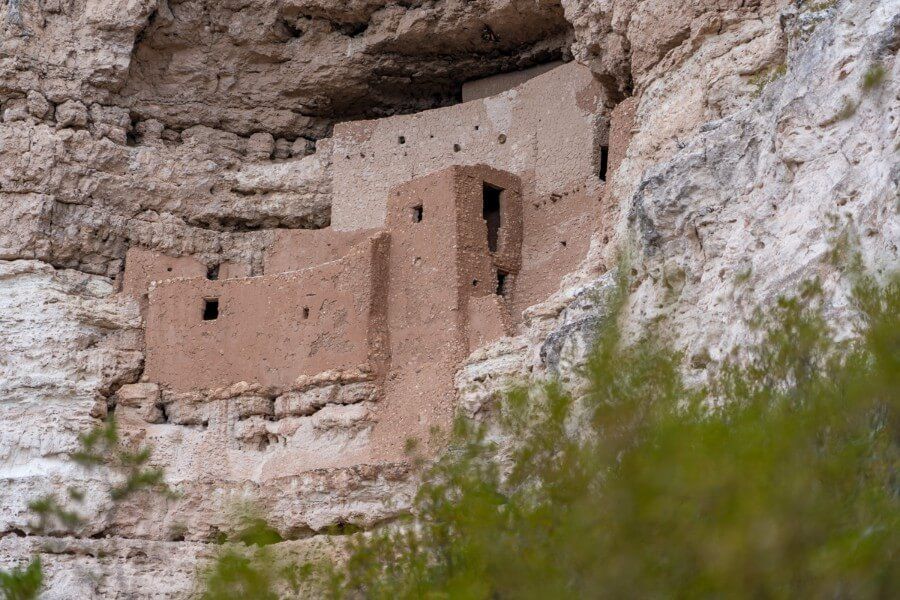
Created in 1906 by President Theodore Roosevelt, Montezuma Castle National Monument protects several historic cave dwellings. It was one of the first four national monuments created through the Antiquities Act of 1906. It’s the third national monument dedicated to preserving Indigenous culture.
Shortly after becoming a national monument, the National Park Service undertook several major stabilization projects to help repair almost a century of looting and digging damage by treasure hunters.
Tourists were originally allowed to enter the ruins via a series of wooden ladders until 1951 when the structure was deemed too unstable. Visitors can no longer go inside Montezuma Castle and access inside the ruins is only for official reasons.
Tip: When exploring outdoors, be sure to always practice the seven principles of Leave No Trace to preserve natural beauty so others can enjoy the same environments.
Montezuma Castle Tickets
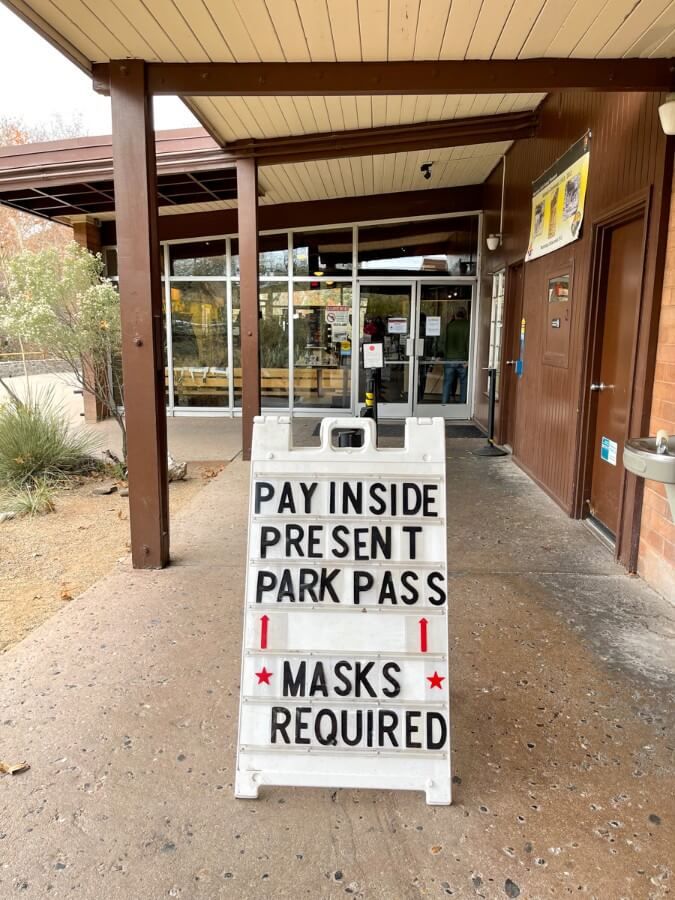
In order to enter Montezuma Castle National Monument, you will need to purchase an entrance pass. The cost for this pass is $10 per adult and free for children 15 years of age or younger.
This pass is valid for 7 consecutive days and gives you entry in both Montezuma Castle and nearby Tuzigoot National Monument. Be sure to save your receipts if you plan to visit both areas. You can purchase this pass online here or at the door when you visit.
If you have an America the Beautiful Pass, you will receive free entry into both Montezuma Castle and Tuzigoot. Similar to the national parks, you just show your signed pass for entry.
The Montezuma Castle visitor center is open daily from 8:00am-4:45pm with last vehicle entry at 4:45pm. But the park is closed on Thanksgiving, Christmas and New Years Day. It also closes at 1:45 p.m. on Christmas Eve and New Years Eve.
In addition to seeing the castle and well, you can stop by the exhibits and see numerous artifacts which showcase the lifestyle of the Sinaguan people. Ranger led programs are offered late morning and early afternoon, but these guided tours are currently postponed. For more information, visit the official website.
Dogs are allowed at Montezuma Castle National Monument, but must remain on a leash no longer than six feet. Available services include a bookstore, restrooms and numerous picnic areas.
Castle Visitor Information
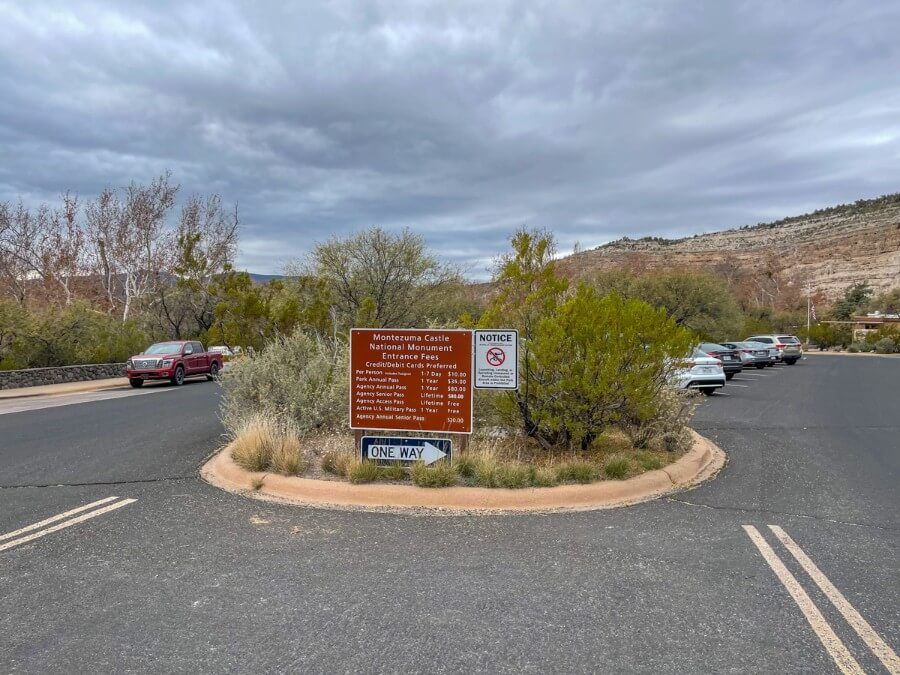
Montezuma Castle National Monument is located about 90 minutes north of Phoenix or 45 minutes south of Flagstaff in Camp Verde close to the extremely popular tourist destination of Sedona.
Most people visit this historical site as a day trip from Sedona because it’s only 25 miles south and just a few minutes off the I-17 making this national monument easily accessible.
- Address: 2800 Montezuma Castle Road, Camp Verde, AZ 86322
- Location: Google Maps
Here are directions for Montezuma Castle:
Follow highway I-17 to exit 289 for Middle Verde Rd then drive east straight through two traffic circles for about 0.5 miles to the blinking red light. Take the next left to Montezuma Castle Road and follow for about 2 miles. This road will terminate in the parking lot for the national monument.
Trail Walkthrough
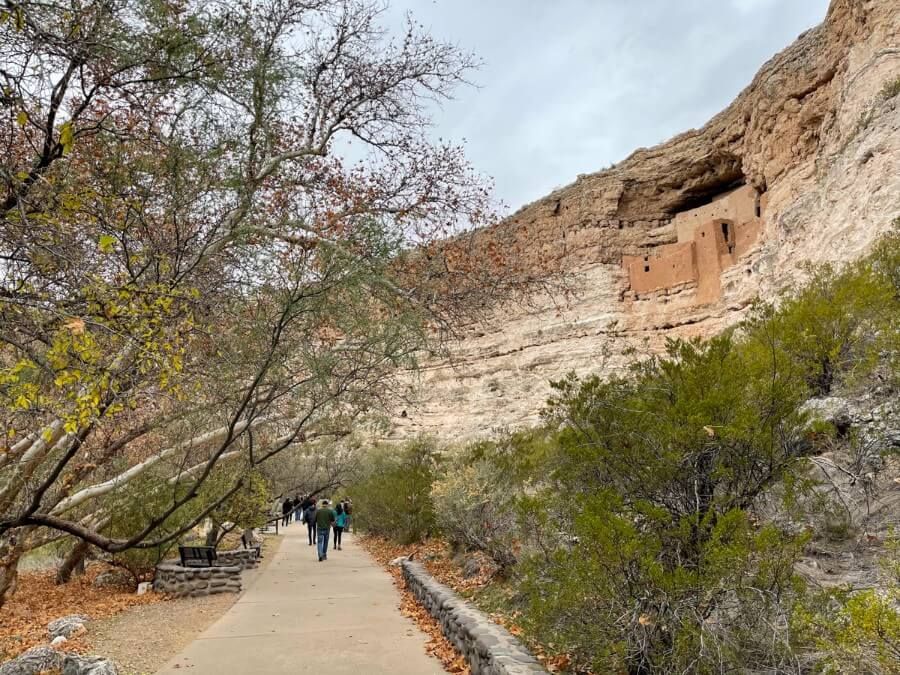
Once you arrive at the parking area, the castle itself is only a short 2 minute walk along an easy 1/3 mile paved ADA accessible road. The Montezuma Castle trail is a paved path which leads past the ruins and loops back along Beaver Creek.
As you walk the path, you are surrounded by white barked Arizona sycamore trees. Several exhibits explaining 900 years of ancient Sinagua culture are also on display.
After a short distance from the visitor center, Montezuma Castle slowly reveals itself. The ruins are extremely impressive when you lay eyes on it for the first time. Keep an eye out for lizards, song birds and rock squirrels because animals are often found along the short hiking trail.
Travel Tip: Take a moment to find some shade in the large sycamore trees and have a picnic as you admire the cliff dwelling from below.
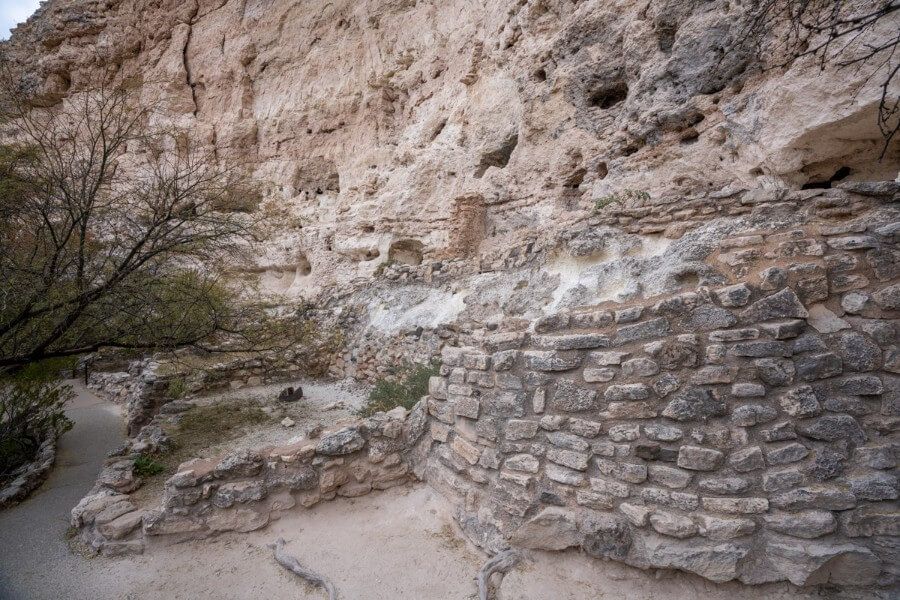
There is another much smaller and less preserved complex known as Castle A about 50 ft west of the main dwelling. The paved path terminates at this location before looping around so it’s easy to find.
Archeologists estimate Castle A was much larger than the main dwelling with a whopping 45 rooms. This ruin was constructed up the face of the cliff in a series of terraces.
Unfortunately, Castle A was not as well protected from the elements so it has succumb to erosion. Archaeologists also suggest historical evidence of a fire. All that remains of Castle A is an outline of foundations surrounded by cacti and local plants. Be sure to take note of the additional walled-off alcoves further on the cliff face.
It’s fascinating to think about how these Castles were built around the same time, yet the main dwelling has remained so much more intact.
Need help planning your trip to Sedona?
Our Sedona travel guidebook gives you hidden gem hiking trails, secret caves, vortex sites, ancient ruins, wineries, jeep trails, photo spots, where to eat and stay, 1-5 day itinerary ideas and much more. Plus, you’ll get an exclusive map to use in Sedona!
View Guidebook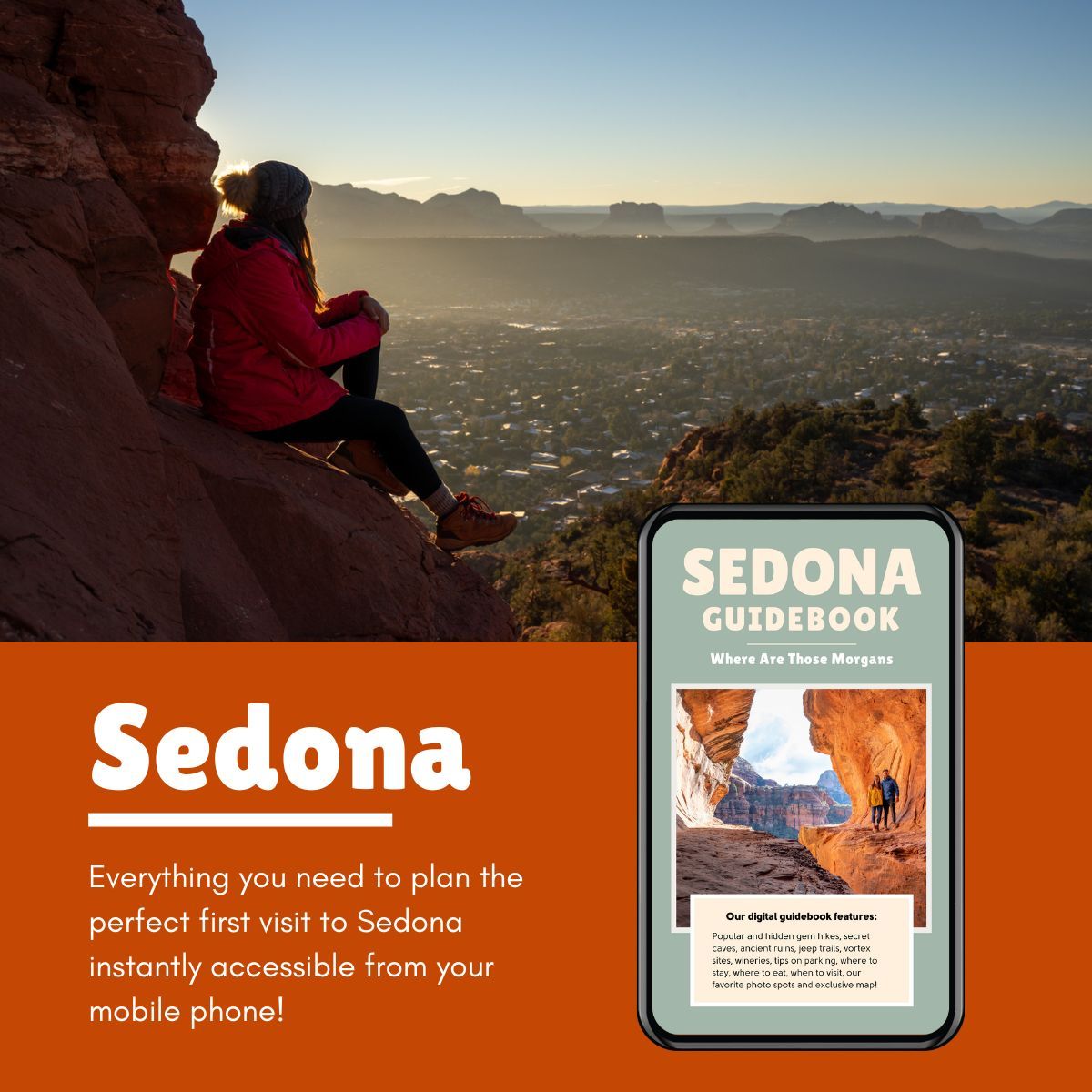
What Is Montezuma’s Well?
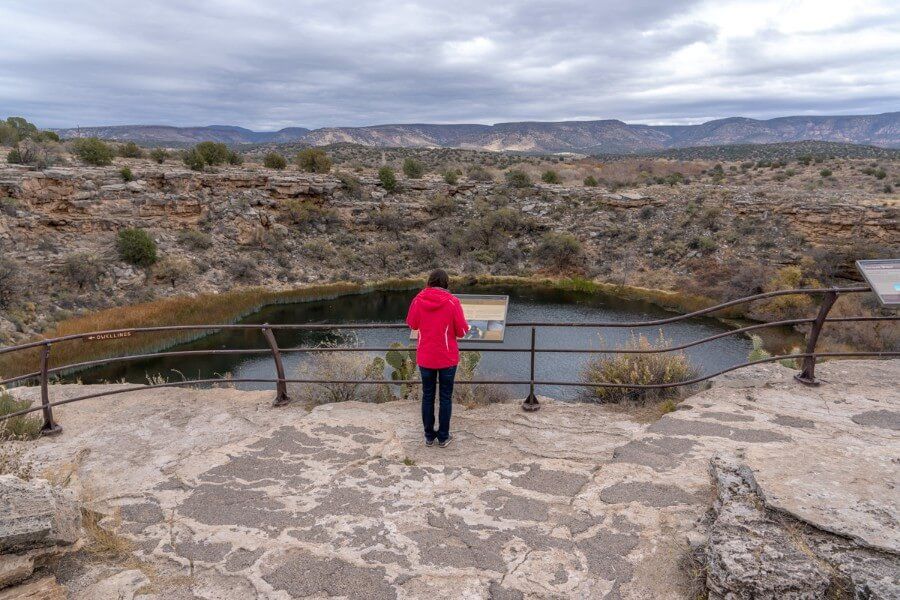
Montezuma’s Well is a subunit of the Montezuma Castle National Monument. It’s a natural limestone sinkhole located about 11 miles northeast of the castle spanning 386 feet in diameter when measured rim to rim.
The water at Montezuma’s Well is about 55 feet deep with an average temperature of 70°F containing high levels of arsenic and carbon dioxide. Many fish can’t survive in these harsh conditions, but this provides the perfect environment for five endemic species including:
- Water scorpion
- Springsnail
- Diatom
- Amphipod
- A new species of leech
Montezuma’s well and outflow tunnel is the only place on the planet to support these five endemic species. While the well seems like a peaceful place, there are many dangers lurking beneath the surface. You wouldn’t want to swim in the well due to high levels of arsenic and numerous leeches.
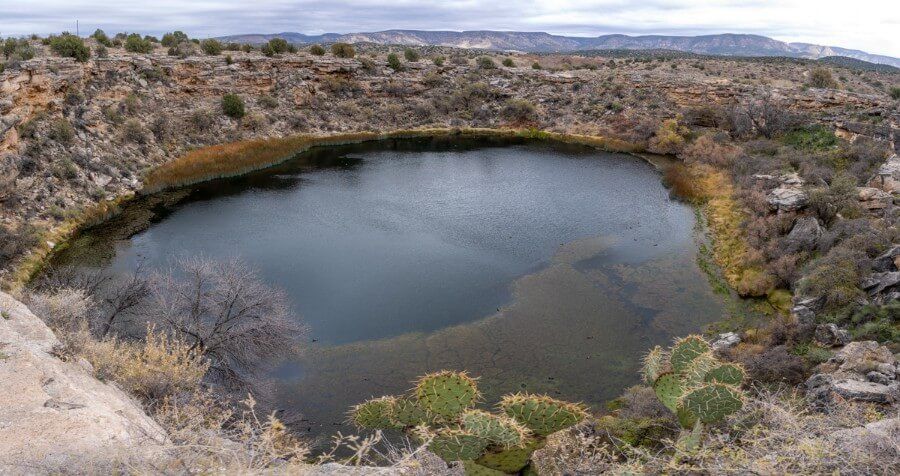
For years, this water oasis in the desert was a mystery because the area receives less than 13 inches of water a year, but the well always contained over 15 million gallons of water.
In 2011, the mystery was solved thanks to the discovery of an underground spring. The spring is continuously fed by water runoff from rain and melted snow along the Mogollon Rim.
Water then trickles down a wall of volcanic basalt this acts like a dam and forces water back to the surface. Every day the well is replenished with about 1.5 million gallons of water.
It’s interesting to note that as water runs through numerous layers of rock, a chemical signature creates a very unique ecosystem within the well. You can see a video of the first NPS divers to explore the depths of Montezuma Well here.
Indigenous History Near The Well
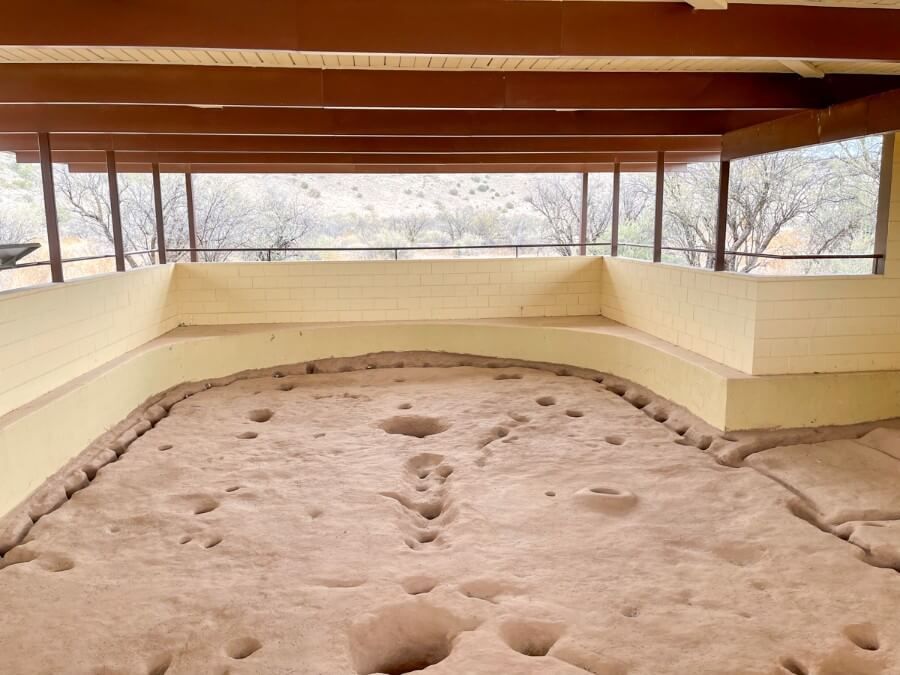
The Montezuma Well has been an attracting settlers for hundreds of years. Maybe even thousands of years as we have learned from archaeological studies. Similar to Montezuma Castle, permanent settlements were built into the rocks. But there is evidence of multiple cultures living symbiotically while harnessing the power of the water from the well.
Before you reach the main parking lot, be sure to take a detour to the pithouse along Montezuma Well Rd. The pit house dates back to 1050 AD and it’s a beautiful example of Hohokam architecture.
The Hohokam people channeled the water from the well into a nearby canal. This system ran for miles and irrigated crops such as corn, beans and squash.
By the 1100s, the people of the Sinagua culture began building small structures into the cliffs surrounding the well with more than 30 rooms along the rim. There were believed to be about 40 to 60 villages dotting the banks of the waterways.
By 1425, most people had migrated onto other areas for an unknown reason. But the Hopi, Zuni, Yavapai and Western Apache all describe oral histories of ancestors living here.
Well Visitor Information
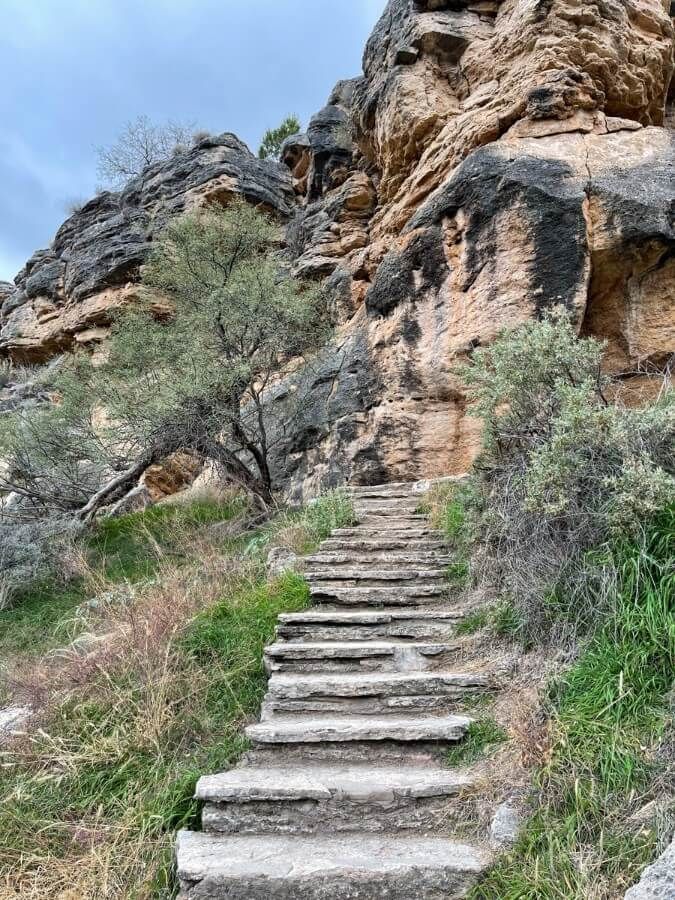
Montezuma Well does not have a large visitor center, but there is a small kiosk often staffed with rangers if you need additional information. Most visitors walk along the main well trail which is open daily from 8:00am to 4:45pm with last vehicle entry at 4:45pm.
Similar to Montezuma Castle, the park is closed on Thanksgiving, Christmas and New Years Day. It also closes at 1:45pm on Christmas Eve and New Years Eve. Visitors can enjoy ranger led programs, walking trails, a gift shop and picnic areas at Montezuma Well. The picnic area is open daily from 8:00am-4:00pm.
Available services include both pit and flush toilets in the picnic area. There is no water available at the main loop trail, but there is a water refill station at the picnic area. For more information, visit the official website here.
The address for Montezuma Well is Forest Service Rd 618, Rimrock, AZ 86335. You can access it on Google Maps here.
Here are directions for Montezuma Well:
Follow I-17 to exit 293 for AZ-179 N towards Sedona which is north of the exit for Montezuma Castle. In about 4 miles, turn left onto AZ-179 S. Continue onto Forest Service Rd 618 for about 0.5 miles. Then turn right onto Montezuma Well Rd and follow this road for about 3 miles until you reach the parking lot.
Trails At Montezuma’s Well
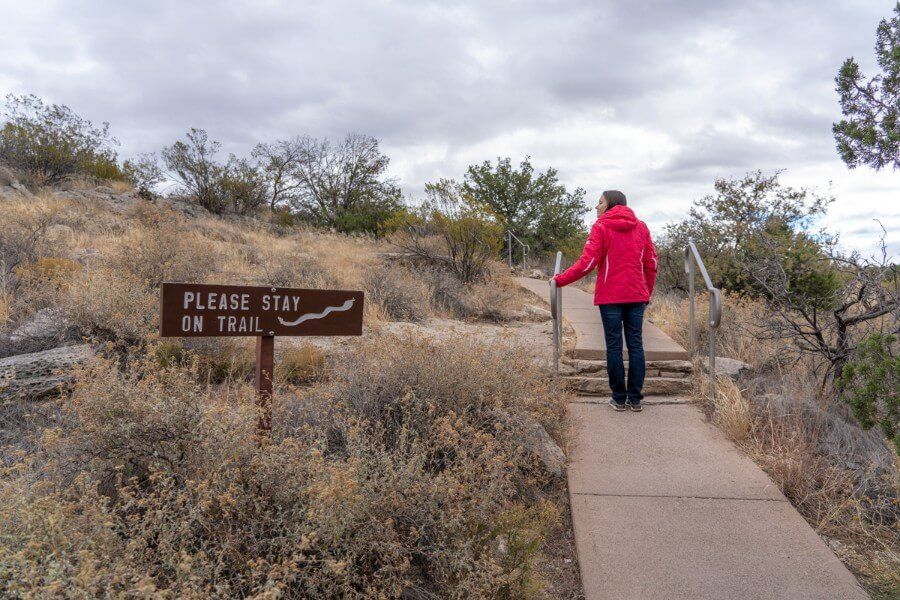
The trails around Montezuma’s Well are easy, short and paved. Unfortunately, several hills and many stairs prevent this park from wheelchair accessibility.
As we mentioned earlier, the phenomenon of Montezuma’s well provides a unique landscape. But it’s also home to a variety of wildlife including 100 species of birds, snakes, mammals, lizards and insects.
When we visited, there were several professional photographers taking photos of the wildlife so be mindful of photographers and critters as you explore the park. Once in the main parking lot, you will see the contact station for the national monument.
The main loop trails starts just past this building. Be sure to stop by and visit the ranger before starting on the trail to learn about the Well.
1. The Rim Trail
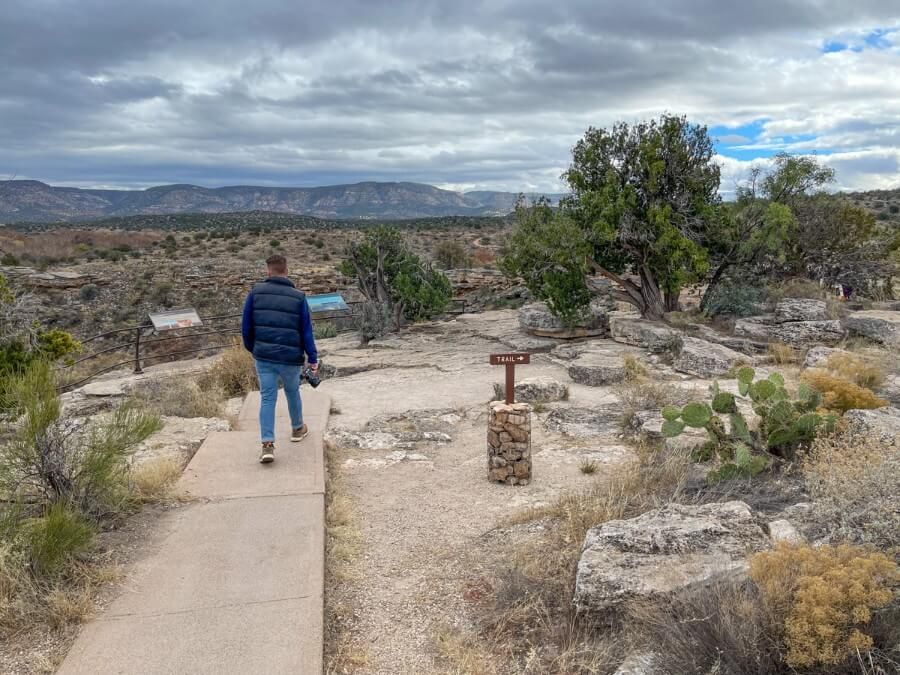
The rim trail at Montezuma Well is a 1/3 mile well marked paved trail. After walking up a small hill for about 85 yards, you will be rewarded with a great view overlooking the entire well and a prehistoric cliff dwelling to your left.
When you are standing at the rim, it’s easy to see why many cultures flocked to this oasis in the desert and called it home for so many years.
Along the trail, there are plenty of signs discussing the history and how plants were used in each culture. Rangers often walk the trails answering any question you may have.
You can then choose to walk the 1/3 mile paved loop trail which will bring you back to your car. Or you can continue along the other short trails past other ruins and the irrigation channels.
2. Swallet Cave Ruins
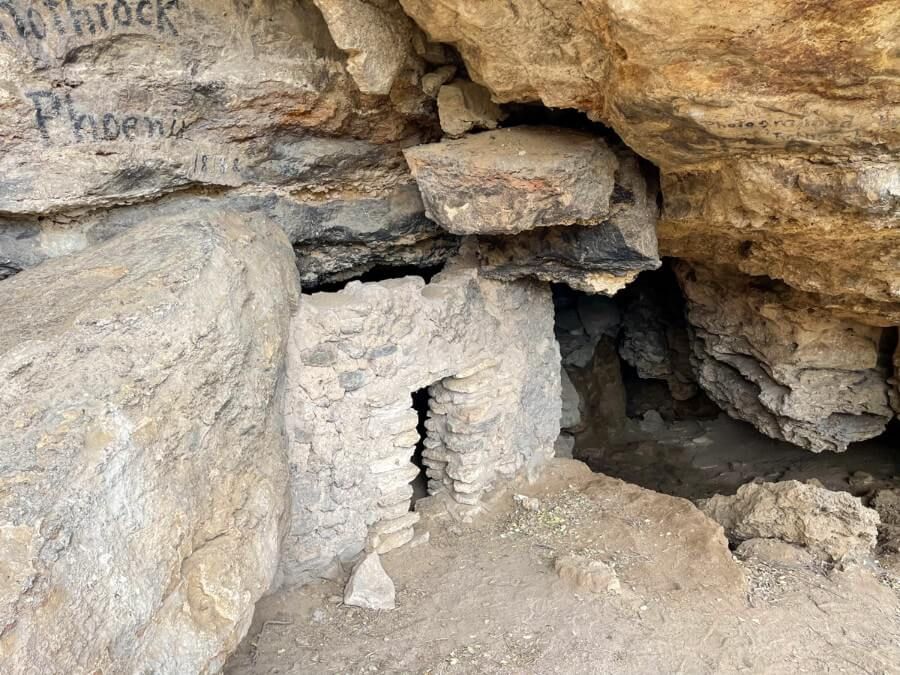
After you walk to the rim, don’t miss the optional trail down to the swallet ruins. This short trail will descend about 120 steps closer to both the water and a few swallet cave ruins. It’s a great way to escape the hot Arizona heat due to the lush vegetation. However, be sure to stay on the trail and watch for snakes.
At the end of this trail, you will terminate at the swallet cave ruins. They were inhabited between 1100 and 1425 AD. It’s impressive to see how these ruins go back into the limestone about 30 meters for protection.
If you continue left a little further, you will see the swallet of the well. This is the exact location where the water exits the main sinkhole out to the irrigation systems on the other side of the well. Now you will have to turn around and climb back up those 120 steps to rejoin the main loop.
3. Water Outlet And Beaver Creek
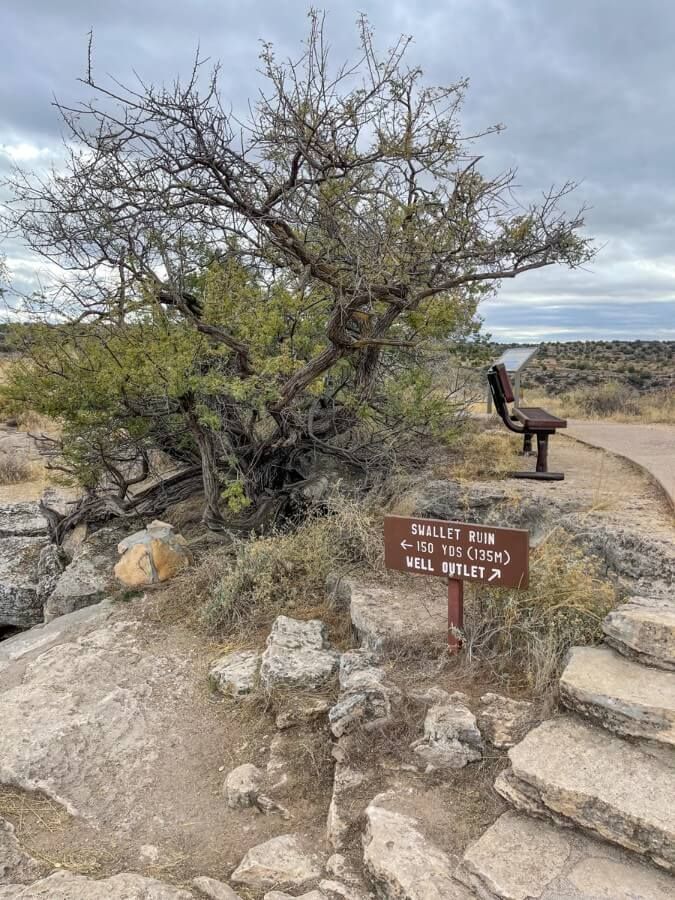
Back on the rim, the trail continues towards a water outlet with more ruins running along the top. Located to the west, there is another side trail which leads you down to the water outlet with another 50 steps.
Montezuma’s Well has provided a steady outflow that has been used for irrigation purposes dating back to the 8th century. It’s here you will be able to witness this prehistoric canal dug by the Sinagua.
This canal still carries over a million and a half gallons of water a day. It’s amazing to see how this canal is still functional just as it was when the Sinagua relied on it to irrigate their fields. You can also see Beaver Creek which provided a decent source of water and fish for the Sinagua.
As you head south, there are grand cottonwood and sycamore trees that line Beaver Creek. This is a great area to have a picnic with the family.
Don’t miss the new trail at the back of the picnic spot and walk through the revegetated area filled with native plant species. From here, you can go back to the main loop which will take you back to the parking lot.
Tips For Visiting
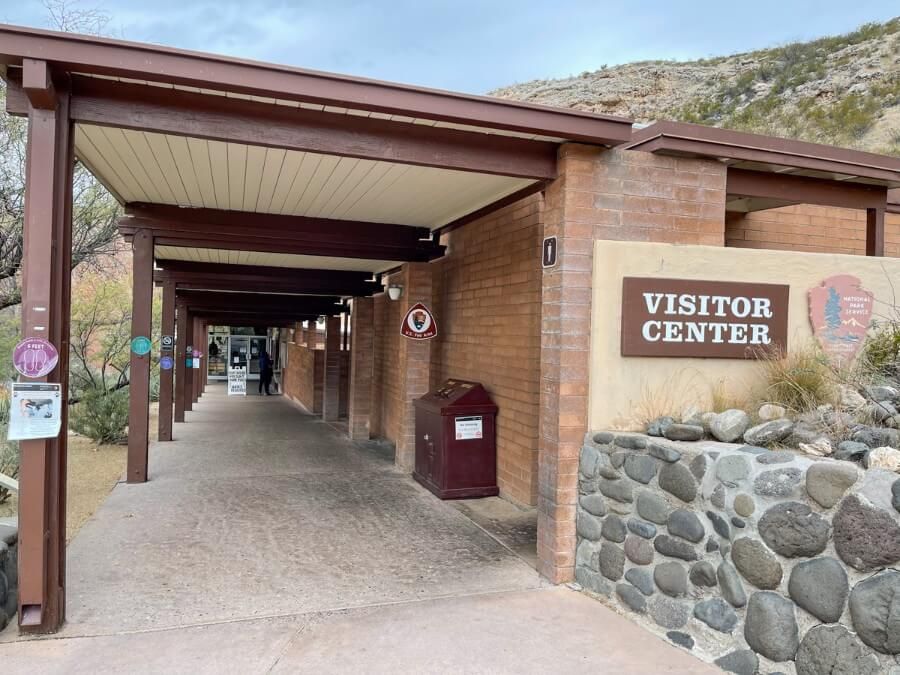
We’ve covered everything you need to know in this guide, but here are a few important tips to consider for your trip:
- If you visit in the summer, start your day early to avoid the heat.
- Read the displays found along the hiking trails because they are very informative.
- Rangers can be found on the trails and will help answer any questions.
- Don’t miss all 3 hiking trails at Montezuma’s Well.
- Take your time when visiting both sites to fully appreciate the ancient history.
- Use your America the Beautiful Pass to receive free entry.
If this is your first time visiting, start with Montezuma Well and then loop around to Montezuma Castle. From the castle, you can then easily go on to visit Tuzigoot National Monument or some of Sedona’s popular wineries.
But if you only have enough time for one spot, here is what we recommend:
- Montezuma Castle – Great for history buffs and visitors with limited accessibility
- Montezuma Well – Good for hikers and those who want to get away from the crowds
Travel Tip: Montezuma Well was not very busy compared to Montezuma Castle, so if you need a break from the crowds, head to Montezuma Well
Best Time To Visit
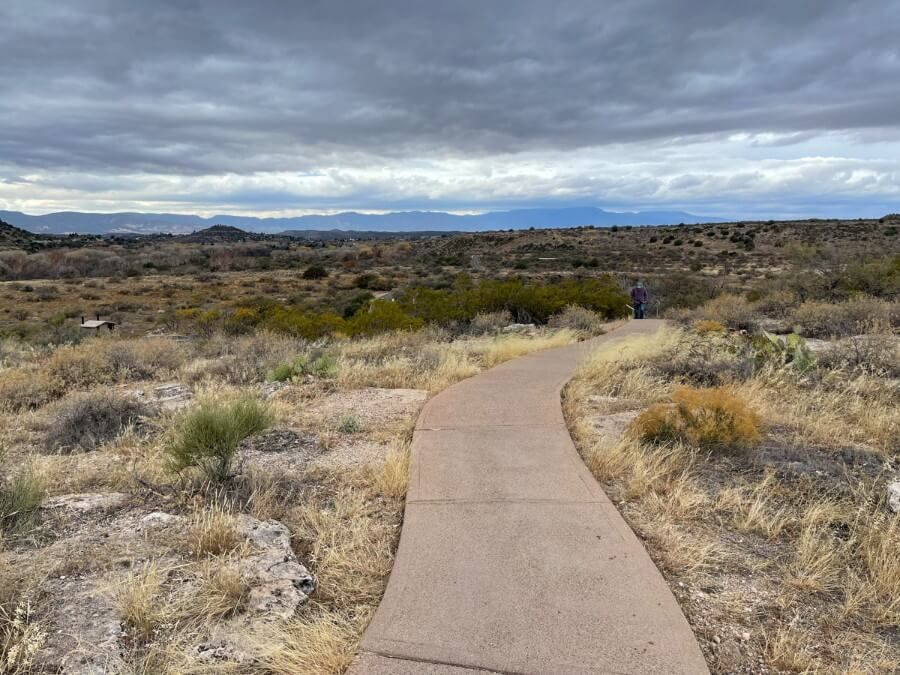
Spring and fall would be the best time to visit Montezuma Castle when temperatures are cool. Arizona summer days are extremely hot ranging anywhere from 95°F to 110°F. Heavy rains are common in late June to early August during the early afternoon. It’s important to drink plenty of water and hydrate properly, especially in the summer months.
Montezuma Castle National Monument is open year round. We visited Sedona in December and the weather was perfect for hiking at about 60°F. Visiting in the off season also meant fewer crowds.
Winter days in Arizona tend to have an average temperature of around 60°F with lows commonly in the teens. Snowfall is rare but is possible. Be sure to check the weather forecast when you visit and plan appropriately. You can check for weather warnings in the area on the NPS website.
The Morgan Conclusion
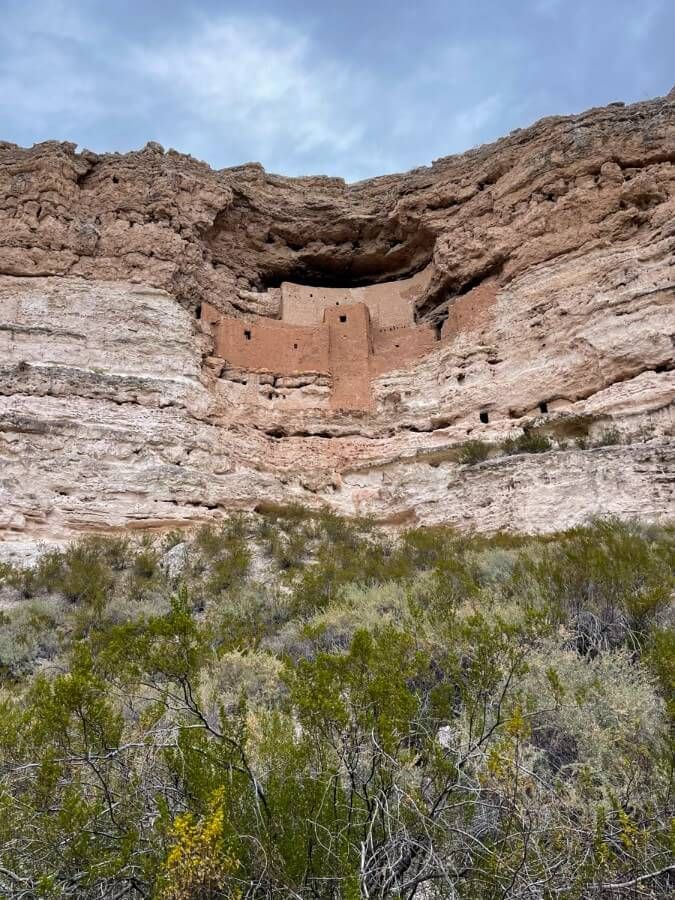
The cliff dwelling found at Montezuma Castle is very impressive and Montezuma Well showcases smaller pueblos and an irrigation ditch that is still in use today. Both historical sites offer a different glimpse into the life of the local indigenous cultures and we enjoyed walking around them.
Is Montezuma Castle National Monument worth it?
Yes, Montezuma Castle is worth visiting if you’re interested in ancient and indigenous history. The dwelling here really is unique, and the walking trails are short and paved so most visitors can easily access all areas of the monument.
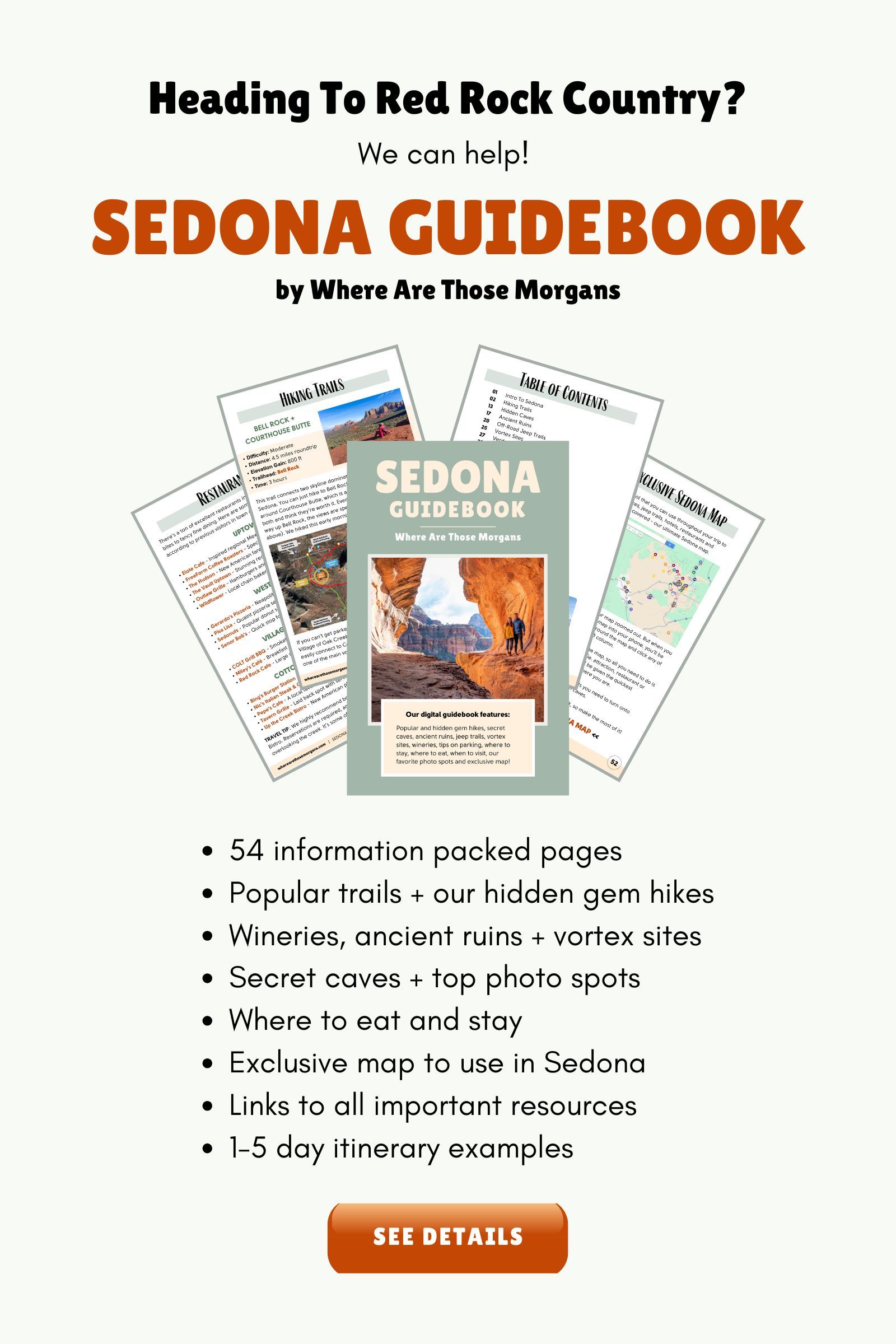
Next Steps
We hope our guide to visiting Montezuma Castle helps with planning your trip to Sedona.
Don’t forget you can book a travel planning video call with us if you’d like our expert help organizing your trip to Sedona. We can answer any questions you have or walk through a personalized itinerary to make the most of your time.
Still researching for your trip?
- Key things to know about visiting Sedona
- Here are the best things to do in Sedona
- Here’s exactly where to stay near Sedona
- These are the top hikes in Sedona
- Here’s our 1-5 day Sedona itinerary
- This our ultimate one week Sedona itinerary
Finally, if you’ll be visiting more places on the same trip, we recommend reading our Arizona travel guide for more helpful tips and advice.
Happy Travels,
Mark and Kristen
Enjoy this guide? Pin it for your visit!
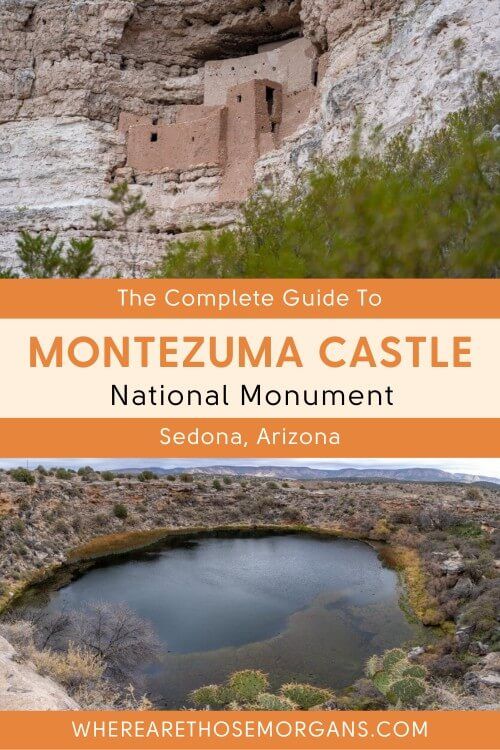
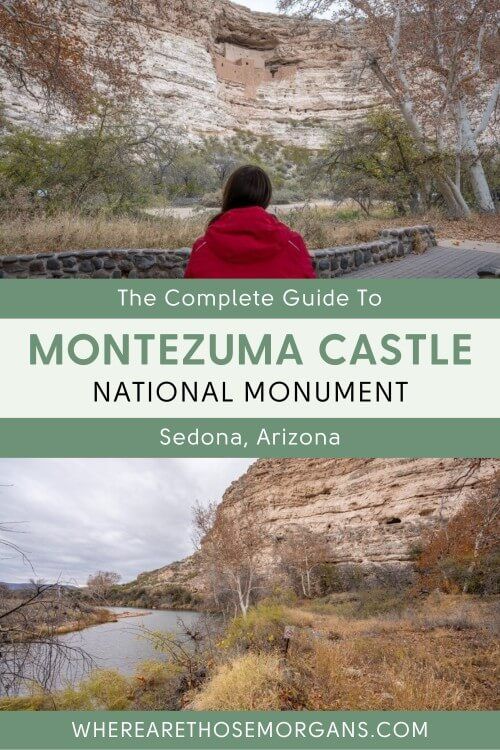
All Rights Reserved © Where Are Those Morgans, LLC. Republishing this article and/or any of its contents (text, photography, maps, graphics, etc.) in whole or in part is strictly prohibited.

